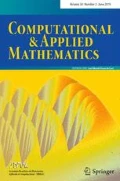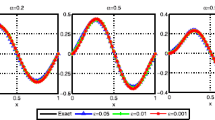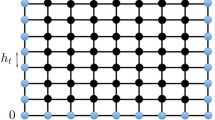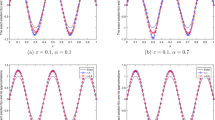Abstract
The diffusion equation has many applications in fields such as physics, environment, and fluid mechanics. In this paper, we consider the problem of identifying an unknown source for a time-fractional diffusion equation in a general bounded domain from the nonlocal integral condition. The problem is non-well-posed in the sense of Hadamard, i.e, if the problem has only one solution, the solution will not depend continuously on the input data. To get a stable solution and approximation, we need to offer the regularization methods. The first contribution to the paper is to provide a regularized solution using the modified fractional Landweber method. Two choices are proposed including a priori and a posteriori parameter choice rules, to estimate the convergence rate of the regularized methods. The second new contribution is to use truncation to give an estimate of \(L^p\) for the convergence rate.




Similar content being viewed by others
References
Alizadeh S, Baleanu D, Rezapour S (2020) Analyzing transient response of the parallel RCL circuit by using the Caputo–Fabrizio fractional derivative. Adv Differ Equ 1:55
Arrieta J, Carvalho A (2000) Abstract parabolic problems with critical nonlinearities and applications to Navier–Stokes and heat equations. Trans Am Math Soc 352(1):285–310
Aydogan SM, Baleanu D, Mohammadi H, Rezapour S (2020) On the mathematical model of Rabies by using the fractional Caputo–Fabrizio derivative. Adv Differ Equ 1:1–21
Baleanu D, Jleli M, Kumar S, Samet B (2020) A fractional derivative with two singular kernels and application to a heat conduction problem. Adv Differ Equ 1:1–19
Bakushinsky AB, Kokurin MY, Smirnova A (2010) Iterative methods for ill-posed problems. In: Iterative Methods for Ill-Posed Problems De Gruyter
Can NH, Luc NH, Baleanu D, Zhou Y (2020) Inverse source problem for time fractional diffusion equation with Mittag–Leffler kernel. Adv Differ Equ 1:1–18
Chechkin AV, Gorenflo R, Sokolov IM (2002) Retarding subdiffusion and accelerating superdiffusion governed by distributed-order fractional diffusion equations. Phys Rev E 66(4):046129
Chen W, Ye L, Sun H (2010) Fractional diffusion equations by the Kansa method. Comput Math Appl 59(5):1614–1620
Debnath L (2003) Recent applications of fractional calculus to science and engineering. Int J Math Math Sci 54:3413–3442
Diethelm K (2010) The analysis of fractional differential equations: An application-oriented exposition using differential operators of Caputo type. Springer Science Business Media
Dokuchaev N (2019) Regularity of complexified hyperbolic wave equations with integral conditions. arXiv:1907.03527
Dumitru B, Khadijeh G, Shahram R, Mehdi S (2020) On a strong-singular fractional differential equation. Adv Differ Equ (1)
Dokuchaev N (2019) On recovering parabolic diffusions from their time-averages. Calc Var Partial Differ Equ 58(1):27
Han Y, Xiong X, Xue X (2019) A fractional Landweber method for solving backward time-fractional diffusion problem. Comput Math Appl 78(1):81–91
Herrmann R (2014) Fractional calculus: an introduction for physicists. World Scientific, Singapore
Hendy A, De Staelen RH (2017) Numerically pricing double barrier options in a time-fractional Black-Scholes model. Comput Math Appl 74(6):1166–1175
Il’kiv VS, Nytrebych ZM, Pukach PY (2016) Boundary-value problems with integral conditions for a system of Lame, equations in the space of almost periodic functions. Electron J Differ Equ 304:1–12
Klann E, Maass P, Ramlau R (2006) Two-step regularization methods for linear inverse problems. J Inverse Ill-Posed Probl 14(6):583–607
Kilbas AA, Srivastava HM, Trujillo, JJ (2006) Theory and applications of fractional differential equations (Vol. 204). Elsevier, Amsterdam
Kilbas AA, Saigo M, Saxena RK (2004) Generalized Mittag–Leffler function and generalized fractional calculus operators. Integral Transf Spec Funct 15(1):31–49
Li Z, Sun H, Zhang Y, Chen D, Sibatov RT (2019) Continuous time random walk model for non-uniform bed-load transport with heavy-tailed hop distances and waiting times. J Hydrol 578:124057
Li Z, Chen D, Sun H, Meng Z, Zhang Y, Sibatov RT (2020) Analyzing and modeling sub-diffusive transport of bedload along a heterogeneous gravel bed using stochastic and statistical methods. J Hydrol 125697
Louis AK (2013) Inverse und schlecht gestellte Probleme. Springer, New York
Long LD, Luc NH, Zhou Y (2019) Identification of source term for the time-fractional diffusion-wave equation by fractional Tikhonov method. Mathematics 7(10):934
Luc NH, Baleanu D, Can NH (2020) Reconstructing the right-hand side of a fractional subdiffusion equation from the final data. J Inequal Appl 1:1–15
Luc NH, Huynh LN, O’Regan D, Can NH (2020) Regularization of the fractional Rayleigh-Stokes equation using a fractional Landweber method. Adv Differ Equ 1:1–21
Machado JT, Kiryakova V, Mainardi F (2011) Recent history of fractional calculus. Commun Nonlinear Sci Numer Simul 16(3):1140–1153
Nguyen HT, Le DL, Thinh NV (2016) Regularized solution of an inverse source problem for a time fractional diffusion equation. Appl Math Model 40(19–20):8244–8264
Podlubny I (1999) Fractional differential equations. Academic Press, London
Podlubny I, Kacenak M (2006) Mittag–Leffler function. The MATLAB routine. http://www.mathworks.com/ matlabcentral/fileexchange. Accessed 5 Aug 2019
Pollard H (1948) The completely monotonic character of the Mittag–Leffler function \( E_a\left({-x}\right) \). Bull Am Math Soc 54(12):1115–1116
Povstenko Y (2015) Linear fractional diffusion-wave equation for scientists and engineers. Springer, Berlin
Povstenko Y, Avci D, Iskender EBB, Ozdemir N (2017) Control of thermal stresses in axissymmetric problems of fractional thermoelasticity for an infinite cylindrical domain. Thermal Sci 21(1 Part A):19–28
Rossikhin YA, Shitikova MV (2010) Application of fractional calculus for dynamic problems of solid mechanics: novel trends and recent results. Appl Mech Rev 63(1)
Sakamoto K, Yamamoto M (2011) Initial value/boundary value problems for fractional diffusion-wave equations and applications to some inverse problems. J Math Anal Appl 382(1):426–447
Tarasov VE (2011) Fractional dynamics: applications of fractional calculus to dynamics of particles, fields and media. Springer, New York
Tuan NH, Caraballo T (2021) On initial and terminal value problems for fractional nonclassical diffusion equations. Proc Am Math Soc 149(1):143–161
Tuan NH, Trong DD (2014) On a backward parabolic problem with local Lipschitz source. J Math Anal Appl 414(2):678–692
Tuan NH, Baleanu D, Thach TN, O’Regan D, Can NH (2020) Approximate solution for a 2-D fractional differential equation with discrete random noise. Chaos Solit Fract 133:109650
Tuan NH, Baleanu D, Thach TN, O’Regan D, Can NH (2020) Final value problem for nonlinear time fractional reaction–diffusion equation with discrete data. J Comput Appl Math 376:112883
Tuan NH, Huynh LN, Baleanu D, Can NH (2020) On a terminal value problem for a generalization of the fractional diffusion equation with hyper-Bessel operator. Math Methods Appl Sci 43(6):2858–2882
Uchaikin VV (2013) Fractional derivatives for physicists and engineers, vol 2. Springer, Berlin
Wei T, Wang J (2014) A modified quasi-boundary value method for an inverse source problem of the time-fractional diffusion equation. Appl Numer Math 78:95–111
Wang JG, Zhou YB, Wei T (2013) Two regularization methods to identify a space-dependent source for the time-fractional diffusion equation. Appl Numer Math 68:39–57
Yang F, Ren YP, Li XX, Li DG (2017) Landweber iterative method for identifying a space-dependent source for the time-fractional diffusion equation. Bound Value Probl 1:1–19
Yang F, Ren YP, Li XX (2018) Landweber iteration regularization method for identifying unknown source on a columnar symmetric domain. Inverse Probl Sci Eng 26(8):1109–1129
Yang F, Zhang Y, Li XX (2020) Landweber iterative method for identifying the initial value problem of the time-space fractional diffusion-wave equation. Numer Algor 83(4):1509–1530
Zhang ZQ, Wei T (2013) Identifying an unknown source in time-fractional diffusion equation by a truncation method. Appl Math Comput 219(11):5972–5983
Author information
Authors and Affiliations
Corresponding author
Additional information
Communicated by José Tenreiro Machado.
Publisher's Note
Springer Nature remains neutral with regard to jurisdictional claims in published maps and institutional affiliations.
Rights and permissions
About this article
Cite this article
Luc, N.H., Baleanu, D., Agarwal, R.P. et al. Identifying the source function for time fractional diffusion with non-local in time conditions. Comp. Appl. Math. 40, 159 (2021). https://doi.org/10.1007/s40314-021-01538-y
Received:
Revised:
Accepted:
Published:
DOI: https://doi.org/10.1007/s40314-021-01538-y
Keywords
- Inverse source problem
- Fractional diffusion problem
- Ill-posed problem
- Convergence estimates
- Integral condition
- Regularization




